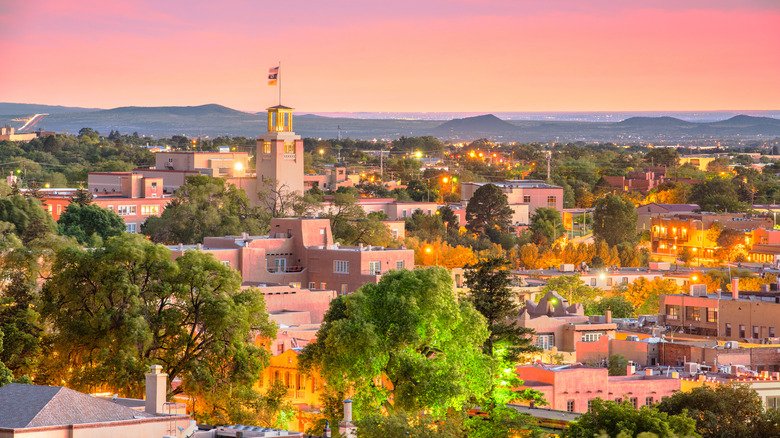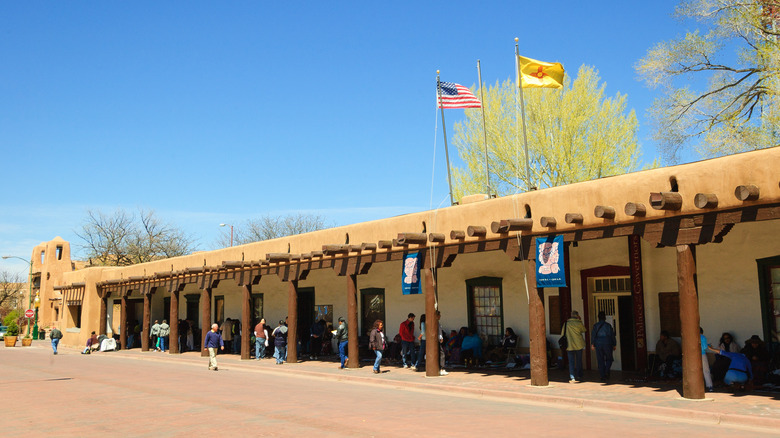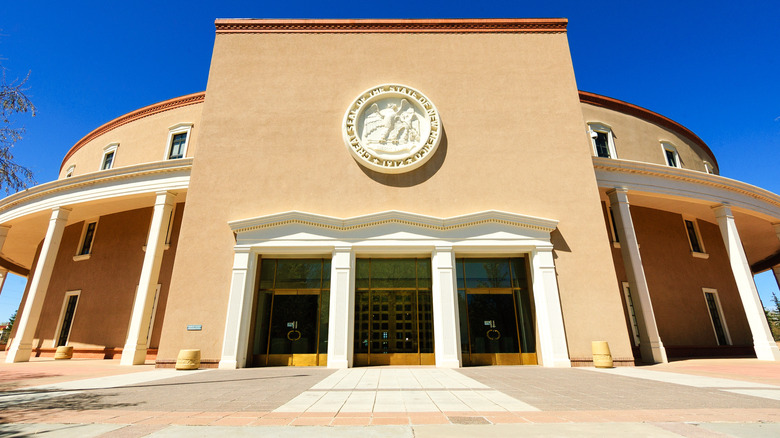Visit The Oldest State Capital In The US At This Southwest Destination
New Mexico has a number of attractions that, for travelers, help the state live up to its official nickname as the "Land of Enchantment." Every October, its biggest city, Albuquerque, holds the world's largest balloon event, allowing visitors to take to the skies in the Rainbow Ryders' colorful hot air balloons. Then there are national parks like Carlsbad Caverns and White Sands, where you can explore the features of New Mexico's stunning — almost ethereal — natural landscape. In the city of Roswell, tourism built up around an alleged 1947 flying saucer incident, and there's even a McDonald's designed to resemble a UFO.
All these things are indeed enchanting from a sightseer's perspective. However, when it comes to history, New Mexico has another major claim to fame in that its capital city, Santa Fe, is the oldest in the U.S. The city also bills itself as America's oldest European community west of the Mississippi River. It was around long before the country came together with the signing of the Declaration of Independence in 1776. First inhabited in 1607, Santa Fe predates the Plymouth Colony, where the pilgrims who came over on the Mayflower ship established New England's first permanent European settlement.
With over 320 days of sunshine each year, the skies are mostly blue here. If you're looking for something a little more down-to-earth than UFOs or hot air balloons, Santa Fe offers not just history, but art and a peek into Native American culture, too.
Santa Fe Plaza and the New Mexico History Museum
A good starting point for a visit to New Mexico's capital is Santa Fe Plaza. It's a National Historic Landmark that puts you right in the heart of the downtown area. The Plaza itself is almost as old as Santa Fe, with the Spanish settlers having used it as a defensive location beginning in 1609. Even today, it remains a cultural center, with a gazebo that doubles as a free concert venue during the annual Fiesta de Santa Fe in early September. The festival brings mariachi music and Pueblo Indian dancers to the Plaza.
Outside August, when the annual Santa Fe Indian Market is held, the Plaza still has the air of an open-air marketplace. Local vendors sell jewelry, pottery, and other handicrafts here daily. They've been doing it since the 1930s, when the New Mexico History Museum started its Native American Artisans Program. The museum is one of several spots where you can get a feel for the city's history as you work your way outward from Santa Fe Plaza.
One notable building in the museum complex is the Palace of the Governors. Constructed in 1610, this was Santa Fe's first capitol building. The long portal to it is where Native vendors set up every day. The National Park Service recognizes the Palace of the Governors as the oldest continually occupied public building erected by Europeans in the continental U.S.
Art and architecture in The City Different
Once you've seen the Palace of the Governors, you might want to check out the current New Mexico State Capitol, also known as the Roundhouse. With a design based on the state flag's Zia sun symbol, it has the unique distinction of being the country's only round capitol. It's not the only interesting piece of architecture in Santa Fe, either.
Just blocks from Santa Fe Plaza are two historic churches, San Miguel Chapel and the Cathedral Basilica of St. Francis of Assisi. The former, which is farthest out from the Plaza, is an adobe-style building that lays claim to being the oldest church in the continental U.S. The latter, founded in 1610 when Santa Fe became a city, contains a statue that is America's oldest representation of the Virgin Mary.
A place for art lovers, Santa Fe is also nicknamed The City Different. UNESCO recognizes it as a Creative City, where one out of every 10 jobs relates to arts and culture. Even on a rare rainy day, you can experience that side of the city in places like the Museum of International Folk Art and the Museum of Indian Arts and Culture. According to UNESCO, Santa Fe also has more writers in the labor force than any other U.S. city. One of those writers is "Game of Thrones" author George R.R. Martin, who owns the local indie theater, Jean Cocteau Cinema, and the neighboring Beastly Books. Both are located in the Railyard Arts District.


